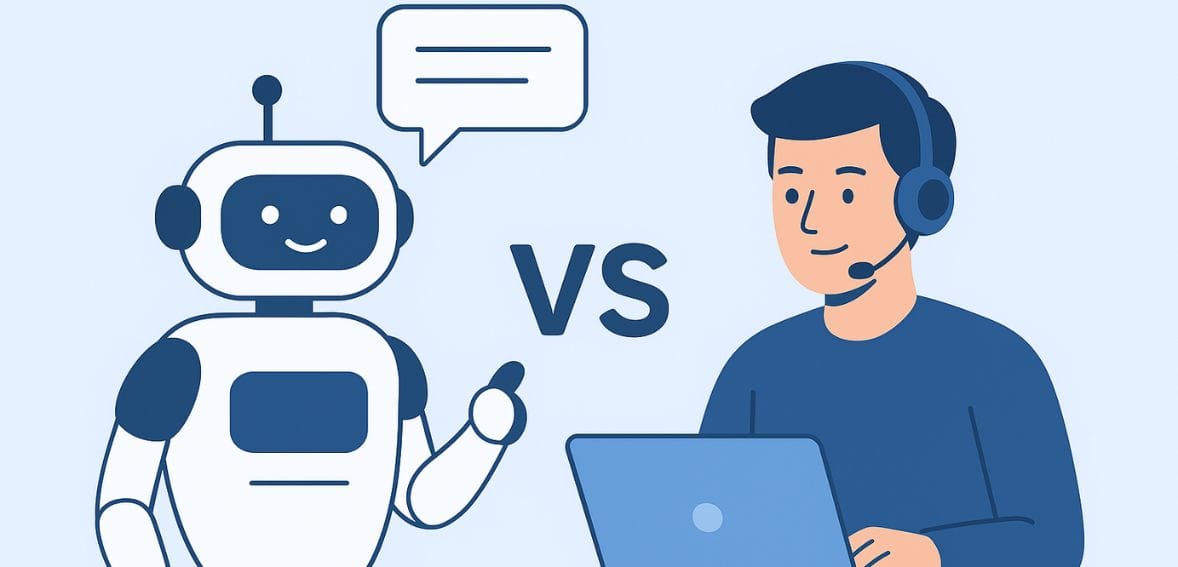
AI Chatbots vs. Live Chat: Which Is Better for Customer Support
The last ten years have seen a significant change in customer service. What used to be limited to phone conversations and lengthy wait times has changed into a technologically driven, on-demand experience. Two significant competitors have surfaced as leaders in modern communication in this new environment: live chat and AI chatbots.
Although they accomplish the same objective—assisting clients in rapidly obtaining the answers they require—they do so in quite different ways. While live chat offers the warmth of human empathy, intuition, and understanding, AI chatbots provide automation, efficiency, and round-the-clock responsiveness.
Nowadays, companies everywhere are forced to consider the crucial question: which delivers better results? The answer isn’t simple, because customer expectations are higher than ever. Knowing how each fits into your customer experience strategy is more important than simply switching between AI chatbots and live chat.
You must explore the strengths and weaknesses of both systems and find the right balance between technology and human interaction to deliver exceptional customer support.
Understanding AI Chatbots

Software-driven assistants known as AI chatbots resemble human-like interactions by utilizing machine learning, natural language processing, and artificial intelligence. Customers can type a question into a chat window and get help right away, saving them from having to wait for human agents.
With the help of enormous datasets, these chatbots are trained to identify trends in consumer inquiries and offer appropriate responses. The most effective AI chatbots don’t just provide pre-written responses. They gain knowledge from each encounter, gradually enhancing their tone and accuracy.
Chatbots offer businesses a scalable solution because they can process thousands of queries at once without becoming tired or inconsistent. They work around the clock, so clients never have to deal with unreachable agents or closed support lines.
Chatbots can now manage intricate workflows, from processing returns to making product recommendations based on historical behaviour, due to the increasing sophistication of AI. However, even with these benefits, how well they are implemented determines how effective they are.
With their irrelevant responses and repetitive loops, poorly designed chatbots can irritate users. Replicating human-like awareness and contextual intelligence that lends the interaction a natural feel is the aim, not just automating responses.
The Human Side of Live Chat

Live chat connects customers with real human agents in real time, combining the speed of digital tools with the warmth of human understanding. Unlike AI chatbots, live chat representatives can read between the lines, picking up emotional cues from punctuation, phrasing, or tone.
For instance, a frustrated client could use capital letters, ellipses, or exclamation points as nuanced signals that AI might misinterpret. A skilled human agent can diffuse tense situations by recognizing frustration and changing their tone accordingly. Live chat is very beneficial for businesses dealing with sensitive or complicated issues because of its adaptability.
Additionally, live chat fosters relationships. Customers’ trust grows when they realize they’re interacting with a real person. Personalized care frequently transforms a bad experience into a good one, encouraging repeat business and loyalty. However, staffing, scheduling, and regular training are necessary for live chat.
For smaller companies that have to strike a balance between operational effectiveness and service excellence, it can be expensive. Human empathy—the capacity to hear, comprehend, and adjust in real time—is what makes live chat so powerful. No machine, no matter how advanced, has been able to completely replicate this quality.
The Appeal of Instant Gratification
Today’s customers expect instant answers. The rise of AI chatbots and live chat is rooted in the modern desire for immediacy. Businesses that fail to respond quickly risk losing customers to competitors who can.
AI chatbots are very good at this. They respond instantly, with no wait times or pauses. Automation offers unparalleled speed and consistency for basic queries, such as tracking orders, changing passwords, or verifying product availability.
Live chat provides depth even though it is a little slower. Human interaction is extremely valuable when a customer’s problem needs to be explained or they need emotional support. Efficiency is what people desire, but not at the expense of misunderstandings.
Users are just as frustrated by a quick response that isn’t helpful as they are by a slow one. In the end, the difficulty is in balancing complexity and response time. Automating simple queries is beneficial, but human intervention is necessary for complex issues. AI for efficiency and live chat for empathy are frequently combined in the best customer experiences.
AI Chatbots: Strengths and Limitations
AI chatbots have completely changed how companies respond to extensive consumer inquiries. Their availability, scalability, and speed are their main advantages. They don’t require human oversight to help clients across time zones. E-commerce platforms can seamlessly manage thousands of concurrent conversations during periods of high sales.
AI chatbots can promote personalization in addition to efficiency. They provide proactive recommendations and customized suggestions by examining consumer preferences, purchase trends, and history. Sales conversions and engagement can both be improved by this predictive power.
Chatbots do, however, have some obvious limitations. They have trouble in situations that are unclear or emotionally charged. Sarcasm, frustration, or mixed intentions are often lost in translation. Moreover, overly scripted bots can sound robotic, reducing user satisfaction.
Convenient experiences become annoying when clients feel stuck in a loop. To seamlessly transfer complex cases to human agents, when necessary, businesses must make sure that chatbots are built with context awareness and a seamless escalation pathway. Human connection should be strengthened by AI, not replaced.
The Value of Human Empathy in Live Chat

Deeper insights are also obtained through empathic interactions. Humans can interpret subtle signals such as tone, hesitancy, or word choice that indicate unfulfilled needs. Over time, these insights assist companies in refining their goods and services. It can be difficult to sustain empathy at scale, though.
Inconsistency, stress, and exhaustion are all experienced by human agents. They run the risk of emotional detachment or burnout if they are not properly trained. One of the biggest problems with human-led support systems is still striking a balance between efficiency and empathy.
It is impossible for any algorithm to fully imitate human empathy. When customers face issues that affect their time, money, or trust, they want assurance and understanding. Live chat agents can not only fix problems but also apologize sincerely, acknowledge annoyance, and provide comfort.
When empathy is present, support shifts from being transactional to being relational. If someone actually listens to a dissatisfied customer and resolves their issue, they may end up being a brand ambassador. The emotional resonance that a personal touch creates can be replicated, but not precisely replicated, by automation.
Scalability: The AI Advantage
Scalability is frequently the determining factor in favor of AI chatbots for expanding enterprises. It can be expensive and time-consuming to hire and train enough agents to manage varying volumes.
On the other hand, chatbots scale easily. AI doesn’t require more workstations or extra compensation, regardless of the volume of inquiries you receive—100 or 10,000. Because of this, automation is a viable option for companies looking to meet seasonal demand surges or global audiences.
Furthermore, AI can deliver consistent quality in every interaction. The same level of care, tone, and accuracy of information is given to each client. AI is not distracted or influenced by emotions like humans are. The benefit of scalability is particularly noticeable during periods of heavy traffic, such as product launches or holiday sales.
AI chatbots maintain continuity in situations where human teams could find it difficult to keep up, avoiding lengthy lines and interrupted talks. Businesses must keep in mind, though, that scalability without satisfaction is meaningless. Poor service-driven growth inevitably backfires.
Complexity Handling: Where Humans Still Win

Even though AI is more efficient, humans are still better at handling complexity. Customer service often involves handling delicate emotional situations, unexpected events, or technical issues that call for creativity. Live chat representatives are flexible enough to understand context in addition to keywords.
They can provide innovative answers, make decisions, and clarify difficult queries that pre-programmed AI systems would not expect. This adaptability is essential for sectors like travel, healthcare, and finance because every client circumstance is different.
AI chatbots continue to rely on patterns and probability despite advancements in natural language processing. They may generate repetitive or irrelevant results when a query is outside of their training data. Human escalation becomes crucial at this point. Companies need to understand that technology works best when combined with human supervision.
24/7 Support: The Nonstop Revolution
The capacity of AI chatbots to function 24/7 is one of their greatest benefits. Clients are no longer required to wait until the morning or stick to office hours. This “always-on” accessibility is ideal for the global economy that prioritizes digital technology.
Providing 24/7 live help is practically impossible for small firms with a tiny workforce. Chatbots fill that void by guaranteeing that no question is left unanswered. The bot can gather information up front, which speeds up and improves follow-up, even if the problem eventually needs human attention.
24/7 coverage is only useful, though, if the quality doesn’t change. Companies need to create chatbots that can efficiently respond to after-hours inquiries without making clients feel unheard or misinterpreted. Reactivity at night is meaningless if accuracy and empathy are lost.
Training and Maintenance: The Hidden Costs
AI chatbots may appear low-maintenance, but they require continuous training and updates. The chatbot’s knowledge base needs to be updated in accordance with changes in consumer expectations and product advancements. Even highly advanced systems run the danger of becoming erroneous or obsolete without this maintenance.
However, live chat representatives also require continual training. They have to remain up to date on new regulations, special offers, and service requirements. However, AI depends on data-driven modifications, whereas humans may learn automatically. Your scale determines how much the two will cost.
While larger organizations frequently use hybrid systems—using AI for initial triage and human agents for resolution—small businesses may eventually find AI to be more cost-effective. The real cost of either model lies not in implementation but in maintaining quality and relevance as customer needs evolve.
Technology and automation in pricing are revolutionizing how businesses test, iterate, and scale their approach. To further enhance efficiency across operations, teams should also consider tools that boost productivity with AI and streamline repetitive tasks.
Customer Satisfaction: The Ultimate Benchmark

Any customer support system’s success is ultimately determined by how satisfied its users are. In different ways, live chat and AI chatbots both enhance good encounters. Chatbots increase customer satisfaction by giving prompt, reliable answers.
They empower clients to resolve issues on their own, reduce friction, and do away with lines. Live chat improves satisfaction by providing comfort, empathy, and personalization. Even if the answer takes longer, client happiness increases when they feel acknowledged and appreciated.
The promise of your brand determines the best course of action. AI-driven automation is a logical choice for businesses that prioritize accessibility and speed. Live chat is still essential for companies that are based on customer service and trust. But more and more evidence indicates that the best overall satisfaction levels are achieved when the two are combined—humans for empathy, AI for speed.
Measuring Success: Metrics That Matter
When assessing support systems, businesses frequently use measures like response time, resolution rate, and customer satisfaction ratings. Humans lead in retention and satisfaction, whereas chatbots typically outperform in speed and volume measures. A comprehensive performance view can be produced by combining these insights.
The objective is cooperation toward common goals—efficiency, empathy, and loyalty—rather than human-AI competition. The most prosperous companies measure and improve both systems constantly. While live agent feedback directs AI development, data from chatbot encounters informs training. This mutually beneficial relationship guarantees that customer service changes along with client demands.
The Future: Conversational AI and Human Collaboration
AI won’t replace people in customer service; rather, it will empower them. With the ability to manage routine activities, collect data, and free up human attention for meaningful involvement, conversational AI is developing into a true companion. AI chatbots will gain a deeper understanding of tone, sentiment, and subtleties as natural language processing advances.
Before a human enters the chat, they will act as intelligent assistants, gathering information. Efficiency and empathy will be redefined by this collaborative ecology. Companies that adopt this synergy will set the standard for the future generation of customer service by combining honesty and quickness.
Technology and automation in pricing are revolutionizing how businesses test, iterate, and scale their approach. To explore a detailed AI marketing tools review that covers how small businesses can automate content, ads, and social media in 2025, dive into this resource.
Conclusion: Choosing Connection Over Competition
Live chat and AI chatbots are allies, not enemies. Each contributes special advantages to the client experience. While live chat offers empathy, flexibility, and trust, chatbots offer immediacy, scalability, and accuracy.
AI provides small businesses with an affordable way to get 24/7 assistance. Hybrid methods optimize emotional depth and efficiency for larger businesses. The real objective is to arrange both in harmony rather than to favor one over the other.
Consumers want more than just convenience—they want connection. Customer care, not just customer service, is the outcome when automation fosters human empathy. In the end, the future belongs to businesses that understand one truth: technology may start the conversation, but humanity always finishes it.